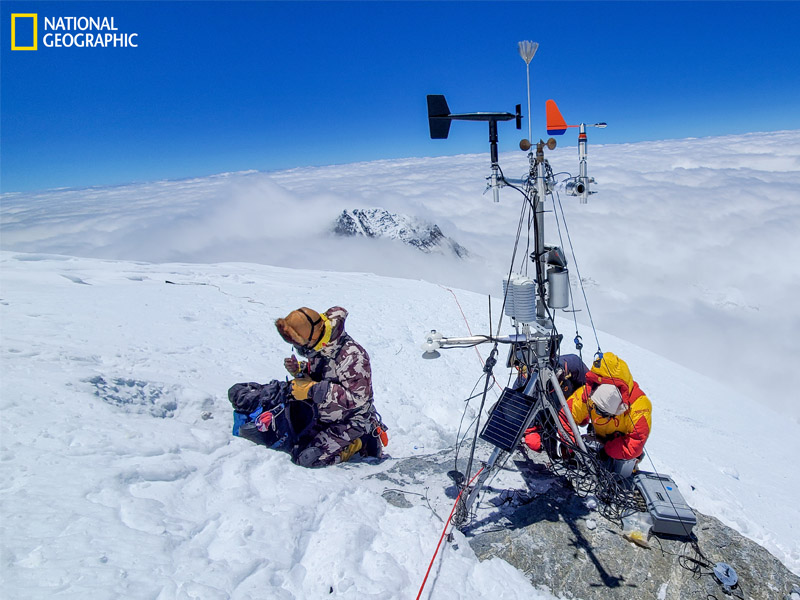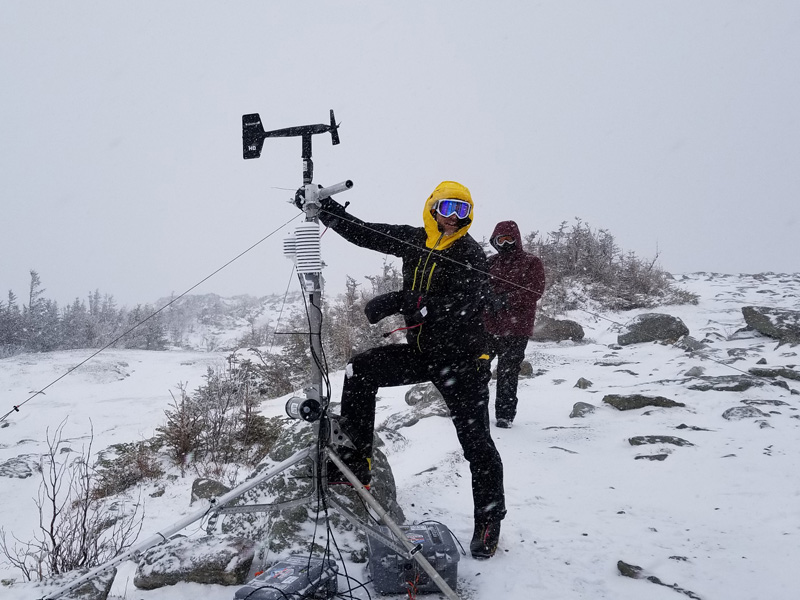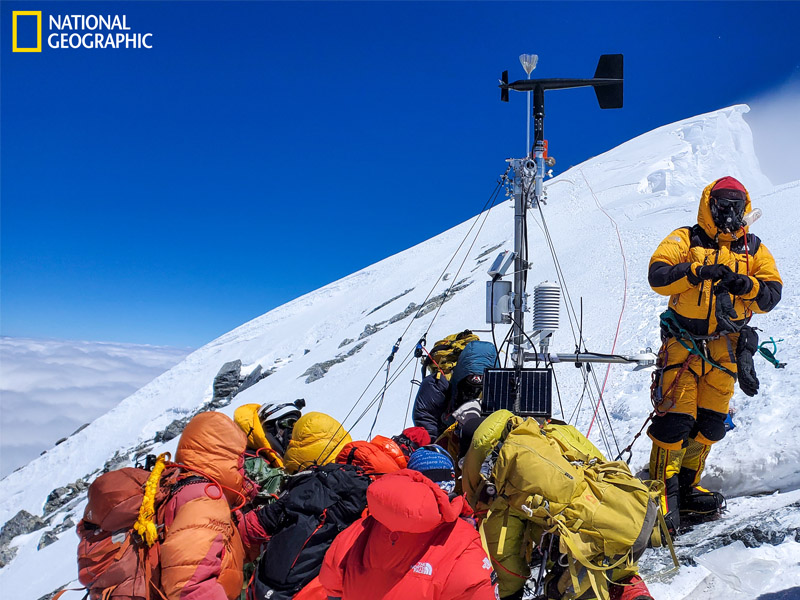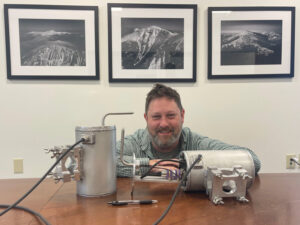Observatory Builds New Wind Sensors for Frontier Science on Everest

The expedition team constructs a new weather station, which includes a Mount Washington Observatory custom-built wind sensor, at Bishop Rock just below Mount Everest’s summit in May 2022. The expedition was supported by National Geographic and Rolex through their Perpetual Planet Expeditions. Credit: Arbindra Khadka/National Geographic. If you value this work, consider supporting our mission.
In May, climate scientists and a cadre of highly specialized Sherpas ventured to Mount Everest to install new automated weather stations at the planet’s outer edge. Their packs held tripods and a load of tech. In the mix were two lightweight wind sensors custom-designed by Mount Washington Observatory.
Expedition leaders Baker Perry and Tom Matthews share a fascination with places where weather dictates everything. This climb continued their quest to measure how snow and ice are responding to the behavior of upper-atmosphere winds, including the jet stream as it meets the Himalayas.
“We need reliable measurements of wind speed and direction,” said Perry, a professor of geography at Appalachian State University and National Geographic Explorer. “With the combination of low relative humidity in winter and exceptionally high wind speeds, there is an enormous amount of snow and ice that sublimate directly into water vapor, into the atmosphere.”
The glacierized area of High Mountain Asia holds vast quantities of snow and ice, and the Himalayas act as water towers to over a billion people downstream.
Conditions at such elevated terrain make climbing exceptionally difficult. Installing weather stations in sub-freezing temperatures adds another level of complexity.
Perry described it plainly: “Once you get above 23-24,000 feet, there’s not a whole lot of fun, there is a lot of suffering.”
With the windchill dipping below -40 °F, on May 9 the climbing team led by Tenzing Gyalzen Sherpa overcame the enormous physical and mental challenges of taking fieldwork to such an extreme, successfully installing new sensors at South Col (elevation: 25,938 feet) and an entirely new station at Bishop Rock (elevation: 28,904 feet), just below Everest’s summit.
It wasn’t their first time on Everest. Perry and Matthews co-led a previous Everest Expedition in 2019, installing stations in the Khumbu region and collecting samples of snow, ice, and soil from extreme elevations. Both projects were supported by National Geographic and Rolex through their Perpetual Planet Expeditions, a partnership harnessing scientific expertise and cutting-edge technology to reveal new insights about the impacts of climate change on the systems that are vital to life on Earth.
A key part of preparing for the 2019 and 2022 expeditions involved pre-testing weather station equipment on Mount Washington, NH, against its reliably extreme weather. A subarctic environment on par with Antarctica and the polar regions, nowhere else in the contiguous United States is able to offer such readily accessible and consistently extreme conditions.

Baker Perry leads installation of a weather station in winter 2018 at 4,000 feet in elevation on Mount Washington, in preparation for the 2019 expedition to install multiple stations on Mount Everest.
In January 2020, Perry and Matthews, a professor of environmental geography at King’s College London and fellow National Geographic Explorer, presented their first Everest Expedition at the American Meteorological Society’s (AMS) annual meeting. Afterward, they met with Observatory Director of Technology Keith Garrett about the operational challenges of the stations they installed in 2019, which at the time had just stopped transmitting data.
The conversation turned to the future of measuring wind in the Himalayas’ high altitudes. They considered the feasibility of installing an Observatory-built pitot static tube anemometer on Everest.
Pitot anemometers, typically used as air-speed sensing instruments on aircraft, have been custom-developed by the Observatory for measuring wind on Mount Washington for decades. A commercial, off-the-shelf alternative that is robust enough to handle the summit’s extreme cold and icing while producing accurate wind speed measurements does not exist.
According to Perry, “the Observatory probably has more experience than anybody around the world at measuring the weather in an extreme location, and in particular, measuring the wind and developing innovative sensors and technology to maintain high-quality wind observations.”
After the 2020 conversation at AMS, Garrett was uncertain. “Automated weather stations in extreme conditions are hard. Many of our stations (on Mount Washington) require multiple visits per year for repairs. We have the luxury of relatively easy access and normal oxygen levels in which to work on them,” he said.
In addition to Mount Washington’s summit, the Observatory manages the Mount Washington Regional Mesonet, 18 remote weather stations that measure temperature, relative humidity, and other variables.
At the Observatory’s summit weather station, staffed and operated 24/7, 365 days a year, instrumentation requires hourly de-icing and maintenance in winter. More extreme events require de-icing the pitot system as frequently as every 15 minutes to keep the data flowing.
By sharp contrast, the automated stations on Everest are at the complete mercy of the weather. Seven months after the Balcony station (elevation: 27,657 feet) was installed in 2019, nearly all of the sensors were destroyed and it went offline. Both wind sensors at the South Col (26,066 feet) were also destroyed about the same time, but not before logging a 150 mph wind gust with temperatures of -40 °F, leaving little doubt as to what happened at the Balcony. Remarkably, the remaining sensors and the station at the South Col survived two full years and even partial burial by monsoon snowfall.
Valuable data and insights had been collected, showing substantial loss of snow and ice even at extremely low temperatures.
“We have observational records from ice cores showing that the top of the core is nearly 2,000 years old, suggesting that the more recent ice may have ablated (been lost) relatively recently. The weather station data allowed us to hypothesize that this ice is missing because of melt and the increase in sublimation that has occurred as temperatures rise a little bit. And if the wind speed increases, that can raise the sublimation rate,” Perry said. “There is a fascinating combination of extreme sunshine, wind, humidity, and temperature that we now know is making the highest elevation of the planet more susceptible to loss of snow and ice.”
In a May 2021 article in the Bulletin of the American Meteorological Society, first authors Perry and Matthews argue for the importance of measuring wind, relative humidity, and other variables in addition to temperature, since loss of snow and ice occurs on Everest “despite persistently below-freezing air temperatures.”
To continue collecting data from the highest mountains in the world, which Perry calls “a critical yet under-monitored cog in the Earth’s climate system,” he and Matthews contacted the Observatory in June 2021 with their request for two custom-designed, portable, low-power, lightweight, durable pitot static tube anemometers – needed in a very limited amount of time.
They planned to install the sensors on Everest the following May during the pre-monsoon climbing season, on new weather stations that would also have satellite communication devices, air temperature and relative humidity sensors, solar panels, data loggers, and other equipment.
Garrett got to work. The next few months were spent discussing instrument needs and specifications, considering the pros and cons of different aspects, and building a proof of concept. Decisions needed to be made in several important areas, including instrument heating and wind direction capabilities.
The Observatory uses a separate vane to track wind direction. A pitot anemometer with both wind speed and direction tracking for Everest would require 360-degree rotation while transmitting power and signal to and from the transducer, which converts pressure to speed data. That dual-function setup has been fraught with power issues and other complications in Mount Washington’s full conditions.
Wind direction was removed from the Everest pitot design given the short time window to source design drawings and parts, the need to reduce instrument complexity, weight, and points of failure, and the team’s primary goal to measure winds from the west. A separate wind vane on the new Everest station tripods would suffice.

The expedition team constructs the new weather station at Bishop Rock in May 2022. Credit: Arbindra Khadka/National Geographic.
Heating the instruments to mitigate icing would also mean additional equipment and weight in the expedition team’s packs. Further, heating the instrument can lead to clogging. As the heating mechanism melts rime ice, the liquid water refreezes almost immediately, often turning to solid ice inside the anemometer as experienced on Mount Washington. This creates a serious issue when no one is there to address it.
With no heat, the instruments are expected to freeze over during the monsoon months of June through September, potentially for long periods of time. Nonetheless, the team removed heating from the design with the expectation that the anemometers can survive icing and recover when the ice buildup sublimates.
During periods when the units freeze, the instruments can still provide useful data. Tracking the freeze, thaw, and operational cycles in conjunction with the other wind monitors, solar radiation, and temperature/relative humidity sensors on the stations can factor into the team’s research.
The nature of this frontier science involves many unknowns. After installing the new weather stations on Everest, Perry and Matthews have no eyes on the instruments to know what’s happening, and the time horizons for going back are long.
But the data being collected helps fill big gaps in what is understood about the outer margins of the planet, where the land surface meets the upper atmosphere.
“Mountains totally perturb the atmosphere. What we think we understand, we don’t necessarily. That’s what we’re learning from Everest,” Perry said. “There are a lot more higher elevations around the planet where snow and ice are so important to sustaining communities downstream. Satellites do not necessarily capture what’s going on.”
According to Perry, if the Everest expeditions can improve understanding of the processes driving the change, and ultimately improve projections of water availability and climate trends, that’s a real plus for planning climate adaptions and risk management.
Since completing the installations in May 2022, both the Bishop Rock and South Col stations have provided valuable data but have gone offline intermittently, presumably due to snow and rime ice buildup on the solar panels and/or satellite antennae (the South Col station was offline for nearly two months previously during the monsoon in 2020 but resumed transmissions in October).
As of this writing, the new Observatory-built pitot anemometer at the South Col is online and being tested with wind speeds in recent weeks nearing 100 mph. The team is cautiously optimistic that transmissions from Bishop Rock will stabilize as winds pick up and relative humidity drops.
 Mount Washington Observatory Director of Technology Keith Garrett is shown at the Observatory’s office in North Conway, NH with the two pitot static tube anemometers (wind speed sensors) custom-built for installation in May 2022 on Mount Everest.
Mount Washington Observatory Director of Technology Keith Garrett is shown at the Observatory’s office in North Conway, NH with the two pitot static tube anemometers (wind speed sensors) custom-built for installation in May 2022 on Mount Everest.
With 90 years of experience measuring extreme weather, the Observatory specializes in instrumentation that can withstand the world’s harshest weather conditions, with Mount Washington serving as an ideal testing ground.
“Mountains make their own weather,” said Perry, who has climbed Mount Washington many times. “What happens at 6,000 feet in the free atmosphere is a lot different from what is happening on Mount Washington. That’s why it’s so important that we have the technology and tools to observe the weather in these places.”
SPECIFICATIONS: Two custom pitot static tube anemometers for installation at South Col (elevation: 25,938 feet) and Bishop Rock (elevation: 28,904 feet) on Mount Everest.
MASS: 2.5kg*
SENSOR TYPE: Omega 0-30 inches of water column wet/wet differential pressure transducer
SENSOR OPERATING TEMPERATURE RANGE: -45 °C to 121 °C
ROUGH SENSOR ACCURACY: 1% full scale at -17 °C to 85 °C, ~2% outside of calibrated range
SPEED CAPABILITIES: ~180 m/s or ~400mph dependent upon station pressure, temperature, and relative humidity. Lower bound of ~10 m/s.
PRIMARY MATERIALS: Custom stainless steel pitot tube assembly from Aeroprobe Corporation, anodized aluminum enclosure
Estimated wind direction angle for optimal readings: +/- ~20 degrees
*The units for Mount Everest are based on a scaled-down version of Mount Washington Observatory’s Next Generation Pitot system. The NextGen system weighs ~30 kilograms, with its control system weighing an additional 20 kilograms. The Everest pitots, lacking a heat/de-ice system, have a final weight of 2.5 kilograms each, allowing them to be carried to South Col and Bishop Rock below the summit of Mount Everest.
From Mount Washington to Antarctica
From Mount Washington to Antarctica By Charlotte Markey What do Antarctica and the summit of Mount Washington have in common besides weather? Having worked as support staff for both locations, I can tell you
Mount Washington Observatory to Host 90th Anniversary Big Wind Day Celebration
Mount Washington Observatory to Host 90th Anniversary Big Wind Day Celebration North Conway, NH – March 23, 2024 – In commemoration of the 90th anniversary of the highest wind speed ever recorded at a
Spring is Here
Spring is Here By Alexis George Our snowpack, although still present, has slowly been dwindling over the course of this month. At the beginning of March, there was a snow depth of 27 inches



